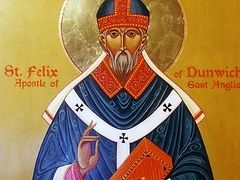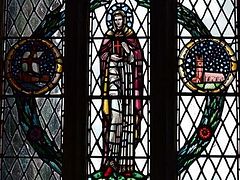 The County of Essex in southeast England stretches from east London to the international seaport of Harwich on the North Sea coast. The name “Essex” comes from the Old English for “East Saxons”, and the present county forms the larger part of the Anglo-Saxon Kingdom of Essex which lasted from the early sixth century until 825 in which year it merged with the Kingdom of Wessex—”West Saxons”.
The County of Essex in southeast England stretches from east London to the international seaport of Harwich on the North Sea coast. The name “Essex” comes from the Old English for “East Saxons”, and the present county forms the larger part of the Anglo-Saxon Kingdom of Essex which lasted from the early sixth century until 825 in which year it merged with the Kingdom of Wessex—”West Saxons”.
England had received the Gospel of Christ about the middle of the first century and the faith was well established during the Roman period. The town of Colchester in eastern Essex was a major Roman city and even now has most of its Roman walls intact and the remains of a fourth century church. Furthermore, one authority says that the Bishop of Colchester was present at the Council of Arles in 314. Turmoil followed the end of Roman rule in England in 410, and the Church there was in disarray. Large areas of England fell back into paganism whilst many Christians fled westwards to Wales and Cornwall. St. Bede tells us that in 604, Sæberht King of Essex converted to Christianity, though as kings came and went Essex oscillated between Christianity and paganism. The Kingdom of Mercia, which was much larger than Essex, bordered Essex on its north-western side, and Mercia’s king, Wulfhere (who reigned from 658 to 675), sought to stabilise Essex and became its overlord, and he it was who arranged the marriage between King Sighere of Essex and Osyth, the future martyr and saint. Such is the background to the life and times of St.Osyth.
 The Anglo-Saxon Seven Kingdoms - detail
The Anglo-Saxon Seven Kingdoms - detail
 Location of St.Osyth village, the medieval Abbey and SS Peter & Paul church
Location of St.Osyth village, the medieval Abbey and SS Peter & Paul church
St. Osyth’s life is known from various sources but since she is not mentioned by St. Bede, the sources do not have his accuracy and do not agree in all details. There is a French twelfth century Life which is written in the style of medieval romance literature and contains details which cannot be corroborated. What can be said is that St. Osyth was born at Quarrendon, which is near Aylesbury north-west of London, and was the daughter of Frewald, a Mercian prince (said by some authorities to have been a sub-king and a convert to Christianity), and his wife, Wilburh, also a Christian. Osyth was brought up in Aylesbury by her pious aunt, Edith. Another aunt was St. Edburga of Bicester. In 673, Osyth, though agreeing to marry King Sighere, obtained his consent to live always as a virgin. (According to other sources, she bore the king a son and later became a nun.) The King, who reigned from 663 to 688, agreed and gave her the manor of Chich and the resources to establish a monastery. Chich later became called St. Osyth, by which name the village is still known. The village is 15 miles (24 km) southeast of Colchester and lies 2 miles (3.2km) from the sea.
 St.Osyth and King Sighere: window in St.Osyth’s Chapel, St.Osyth’s Priory
St.Osyth and King Sighere: window in St.Osyth’s Chapel, St.Osyth’s Priory
Osyth had governed her monastery for many years with great sanctity and was known for her holy way of life, but eventually she was crowned with martyrdom when the monastery was attacked during a raid on the Essex coast by Danish (or Viking) raiders, who ravaged the countryside around and they then came upon the monastery. On the location map above, the Danes would have sailed up Flag Creek in the northwest corner of the map, and Nun’s Wood can be seen just to the east of Flag Creek.
 Flag Creek with Nun’s Wood in the distance
Flag Creek with Nun’s Wood in the distance
Tradition has it that at Nun’s Wood, a short walk north from the monastery, St. Osyth was discovered and the attackers ordered her to come before them and, on pain of torture if she refused, instructed her to worship their gods. She steadfastly refused, declaring she worshipped only the Lord Jesus Christ; upon hearing which she was beheaded for her constancy in her faith and virtue.
Most accounts date her martyrdom at about the year 700. A spring arose at the place of her martyrdom, and though the spring still exists it is within the grounds of a private property. For fear of further raids, her body, after some time, was translated to Aylesbury, and remained there forty-six years, after which it was brought back to Chich.
 The beginning of a Life of St.Osyth from a 12th century French manuscript in the British Library.
The beginning of a Life of St.Osyth from a 12th century French manuscript in the British Library.
The site of St. Osyth’s monastery is believed to have been where the church of St. Peter and St. Paul stands in the village of St. Osyth. This church was built about 1181; at the same time, the monastic life was revived by the building of a priory dedicated to St. Peter and St. Paul and also to St. Osyth. The priory was a monastery of Augustinian canons and grew to become one of the largest and best organised monasteries in all Essex, and was an important centre of learning. It was dissolved in 1539 by King Henry VIII. The monastery was made into a private house and estate and remains in private ownership today.
In most depictions of St. Osyth, she is shown holding a symbolic white stag. This refers to a tradition that whilst King Sighere was out hunting a great white stag, Osyth felt her prayers to be called to the monastic life had been heard, and she obtained a blessing to accept that calling.
Though so little is known about St. Osyth, perhaps that is as it should be for a monastic. There are no long records of miracles, and only three local churches have dedications to her. The French Life says, “Her life was beautiful and glorious, holy, sweet, and precious”. Yet despite the lack of biographical details, it is clear that she is regarded with much love and affection in this area of Essex.
 St.Osyth village with the medieval abbey centre and SS Peter & Paul church lower right corner. Nun’s Wood is extreme top left corner.
St.Osyth village with the medieval abbey centre and SS Peter & Paul church lower right corner. Nun’s Wood is extreme top left corner.
 Stained glass window with St.Osyth at right: Lexden Parish church, Colchester. St.Helena, depicted in the left window, is the Patron Saint of Colchester.
Stained glass window with St.Osyth at right: Lexden Parish church, Colchester. St.Helena, depicted in the left window, is the Patron Saint of Colchester.
 SS Peter & Paul church, site of St.Osyth’s monastery
SS Peter & Paul church, site of St.Osyth’s monastery
 Stained glass window in SS Peter & Paul church, village of St.Osyth
Stained glass window in SS Peter & Paul church, village of St.Osyth
Troparion, Tone 6
Disdaining the love of a man, thou wast clothed in the radiant garment of virginity, and gave thyself to Christ, and fearlessly confessing Him, thou didst receive the crown of martyrdom. O venerable mother Osyth: pray to Christ our God that our souls may be saved.
Kontakion, Tone 4
We honour thee, pure virgin and martyr Osyth, and praise thine illustrious contest. For thou didst desire only the beauty of Christ, and didst disdain all things corruptible. Wherefore, when thou wast beheaded thou didst receive imperishable glory.
Holy Mother Osyth, pray to God for us!




